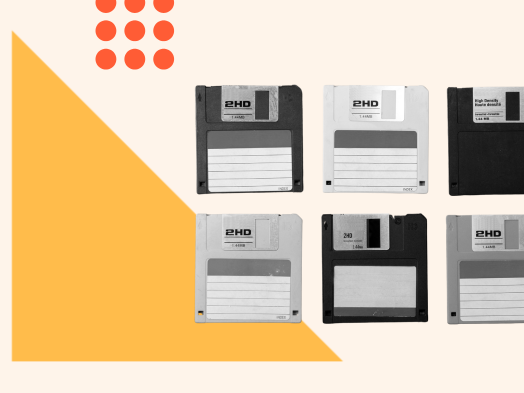I used to be a social media/content strategist who put together elaborate strategy documents to try and convince enterprises they needed to adopt social and start creating and sharing tons of valuable content.
Then I realized I wanted to prove to myself that I could actually walk the talk: I wanted to prove to myself that I could manage an online community and I could produce the kinds of content that got people clicking, sharing, liking, tweeting, and converting.
So, that's what I did. For several years now I've been a creator/writer/designer. For over a year I've been one of the people at HubSpot who produces long-form content, such as ebooks, presentations, and templates that help marketers around the world master content marketing, social media, blogging, SEO, automation, and other components of inbound marketing.
The experience has taught me a few things about what it really takes to produce content that consistently brings in new business opportunities. You learn what matters and what doesn't. You learn where to cut corners and where to spend a little extra time. And you learn that, as with just about everything else, what it takes to be successful isn't always what you imagine.
So, how do we do it? What's it like? What does it take?
Below are seven (of many) truths I've learned about content marketing ,and none of them are, "It's Totally Easy!" But I’m hoping these seven truths will help you focus your efforts, and release you from the shackles of believing that content marketing success is unattainable, too hard, or only reserved for big brands with big budgets.
So, now that we're through the long build-up, try not to fall off your ergonomic desk chair as you read through Truth #1. :-)
1) You don’t need a content marketing strategy.
Every content marketing article will tell you that the first thing you need to do to get started with content marketing (a major component of inbound marketing) is to document a strategy. And here I am, telling you the opposite. Let me explain.
By “you don’t need a strategy,” I don’t mean that you don’t need a plan, or that you don’t need to get your team on the same page. What I mean is that you can say sayonara to those expensive, hefty, 60-page stacks of paper that I used to write and hand off to clients just so they could put them on the shelf to collect dust.
HubSpot doesn’t have a documented strategy, and if we did, it would be of no use to me, one of the people actually creating the content. Our strategy, and the only strategy you really need, is to be helpful to the people we're trying to convert into customers.
The point I’m trying to make is to not spend time documenting things that won’t get used. Instead of crafting a high level strategy that nobody has time to read, create a bare-bones, practical action plan. Then get started. Then create some internal tools and templates to get your team on the same page, knowing that these tools and templates will evolve over time.
Getting started and excelling at content marketing is hard enough, and wasting your time overthinking the perfect way to get started only prolongs results.
If you really want to know what you need in terms of a plan to get started in content marketing; or if you need to refresh your playbook; or you need to have one because your boss said so; check out the Big Fat Content Marketing Strategy Checklist put together by Velocity Partners, a content marketing agency based in the UK. It’s to-date the most useful content marketing planning tool I’ve seen.
Now, what do I mean about by practical tools and templates? Here are some examples:
- Buyer personas.
- A style guide.
- A list of writing do’s and don’ts with examples.
- A list of internal and external experts you can tap for expertise and gut checks.
- PowerPoint presentation templates.
- Ebook templates.
- Guidelines for contributing to the company blog.
- Folders of stock photos, icons, and other ready-to-use design assets.
It’s important to get everyone on the same page in terms of audience, content themes, content types, and templates, but the more effective way to do it is with digestible tools – not gigantic, high-level documents.
2) You can stop obsessing about “storytelling.”
Our industry is absolutely obsessed with “storytelling” right now. If you want to be successful in content marketing, you have to tell compelling stories!
Stop obsessing about storytelling. You are not Pixar. Even if your content is valuable, it’s probably not what your prospects consume for fun. It’s what they consume so they can be better, faster, smarter, or otherwise more efficient at their job so they can go home and then read fairytales to unwind.
Even if you did write some sort of brand story -- whatever that even means -- it probably wouldn’t get read all the way. The percent of words that get read on the average web page containing just under 600 words (about the length of a blog post) is only 28%, or less than a third of the content.
Your job as a business writer is to deconstruct information and present it in a way people can easily absorb. You’re writing about practical solutions to complex problems, not heroes overcoming villains. That means your writing should be very literal, because guess what?
Your readers don’t have the time or patience to sort through your metaphorical B.S. when they really just need to figure out which popcorn machine vendor to choose for the grand opening of their movie theater ... by tomorrow.
Great content creators aren’t necessarily great storytellers, but they are fantastic tour guides: They introduce you to a subject you’re unfamiliar with, and they help you arrive at a certain understanding without losing you along the way.
Besides, stories end. Yet you’ll never be done convincing customers to do business with you. So, instead of obsessing about telling “stories,” obsess about drawing your readers/viewers in with a promise, and then deliver on that promise: What will your content consumer learn from you? How will it benefit them?
Whatever you create must pass the readers’ “what’s in it for me?” test. A reader’s attention is a privilege, not a right.
3) You can forget almost everything you learned about writing in college.
Your college education has no bearing on your ability to write. If you need proof, just go retrieve one of your old college papers. You’d be astounded how ridiculous spending $50,000+ a year makes you sound.
College education having little to do with your ability to write is both a good thing and a bad thing. For some people, it means you have to unlearn some things. For others, it means there’s hope because you don’t need an English or Journalism degree to be a successful content marketer.
Here are some things you can unlearn:
- You will get docked for improper grammar. (It's okay to break some of the rules).
- Length equates to value. (Content should only be as long as it needs to be to achieve its purpose).
- Robust vocabulary equates to credibility. (The goal is to be clear, not clever).
- You get to pick what you write about. (Business writers write what needs to be written).
- You have to follow the rubric. (No such thing exists).
- You have to be perfectly polished. (Done is better than perfect in most cases).
- You have one chance at a final draft (You can update and re-publish later on).
Here's what matters:
- Have a damn good title.
- Formatting matters, and the more scannable, the better.
- Have a ‘So What?’ -- a takeaway that serves as the backbone of a piece.
- Write with empathy.
- Write vividly. (Figurative language, imagery, metaphors ... all those literary devices you learned in school -- look them up again).
- Support your arguments with research, and cite your sources with hyperlinks.
- Revise, because as Ernest Hemingway once quipped, “The first draft of anything is shit.”
Want to know a content creation secret of mine?
My secret framework for writing any piece of content is Who, What, When, Where, How, and Why. If I can communicate ...
- Who this piece of content is for;
- What the reader will learn (my ‘so what’);
- When the reader should take action / When this information becomes applicable (using illustrative examples);
- Where the reader can find more information (research, hyperlinks, CTAs to additional resources);
- How this information relates to our software, and how this information and our software will make the reader's life easier or better; and
- Why the reader should care ...
... I'll remain focused on creating something my audience will actually find useful.
4) Nobody wins the Quantity vs. Quality Debate.
Every organization with a content marketing function struggles with the quantity vs. quality conundrum. If you create too much, you’ll probably burn out and/or your quality will suffer. If you don’t create enough, you might have world-class stuff that is too infrequent to be relevant or impact your business. And no matter what, everyone will continue to tell you "make it better" and "do more of it." Both quantity and quality matter, but it’s the wrong battle to fight.
There are times when quantity trumps quality, and when quality trumps quantity, but consistency trumps both. The reality is this: Most of the time, done is better than perfect. Not everything you publish has to be this magical gem. Some of the content you publish needs to be good enough, and other content you shouldn't publish until it's right. It all depends on the goal. We just finished a new product-centric "What is HubSpot?" video that went through ruthless edits, but on the other hand, we can publish blog posts, offers, emails, and social media posts with much less approval from a Brand Dictator.
To succeed at content marketing, you need to be deliberate about what content you put through the wringer. Be more stringent with your product-centric content, but be more flexible with your content marketing.
5) Content isn't king. Distribution is.
Content marketing is useless if the content doesn’t get consumed. You should spend just as much if not more time thinking about how you distribute your content as you do creating it. Creating a content asset is only the very beginning of the process.
At HubSpot, we aim not to create any “offers” that won’t get promotional support from our email, social, and blogging channels, because when they don’t, they fall flat.
It's also helpful to split up creation and distribution. Creating a worthwhile piece of content can suck the life out of you (and even take its toll on personal hygiene). The last thing I want to do (or should do) after I finished nonstop researching, writing, and designing for an ebook, all while wearing the same sweatpants for three days straight, is to devise a robust social media contest to get people buzzing about it. Either I’m gonna miss a deadline, or corners are gonna get cut. Split it up.
Content creators like me promote our content internally through email so that the individuals in charge of our distribution channels can do whatever they need to do to appropriately position the content to their respective channels.
But you’re still not done once you’ve promoted on your own channels. The general rule of thumb for years now is to house all your content on digital real estate you own, and to drive all traffic to that home base. This is changing a little.
In a world where you have three seconds or less to capture someone’s attention, you start to care less where that captivation takes place. Have a home base, but don’t be afraid to be promiscuous. Get in front of new audiences when you can.
Three ways we try to get in front of new audiences are:
- Writing for LinkedIn, Huffington Post, Forbes, and other business publications, or getting them to syndicate articles that we already published on our blog.
- Working with our agency customers and other partners like Facebook, Twitter, LinkedIn, SurveyMonkey, or GoToMeeting to co-create and co-promote a piece of thought leadership content.
- Working with our PR and Influencer Relations contacts to get marketing thought leaders quoted or somehow involved in our content.
6) You shouldn’t hire “experts,” nor should you hire a bunch of clones.
Be wary of "experts." What you really want are humble, smart, and adaptable people. Expertise, in our industry, is temporary. As Frank Lloyd Wright rightly put it, “An expert is a man who has stopped thinking because ‘he knows.’”
The moment you feel like you’ve got content all figured out is the moment your brand becomes stale. I can tell you first hand that pretty frequently you feel like the rug is pulled from underneath you. Just when you think you’ve got the hang of something and you have a good process around it, you’ll start to see diminishing returns, and it’s time to switch gears. One example: We were getting a lot of traction on blog posts that contained SlideShare presentations. Then we started doing a ton of them. Now they don’t get nearly as many views or shares, because the novelty is gone. It’s time to back off and try something else.
Now, if great content doesn’t come from “experts,” I want to clear the air about where great content does comes from.
Here’s the thing. Most B2B writers don’t have the luxury of choosing which clients they work with or what topics they get to cover, which means two things:
- You won’t be an expert.
- You won't always be passionate about what you’re creating.
Great content stems not from passion, but from perseverance. Critical thinking, research, and grit trump passion. You don’t have to be an expert nor do you have to be passionate about marketing automation software or conveyer belt rubber or waste management to write about it well. What you do have to have, however, is a journalistic curiosity, a willingness to learn, and some good ol’ fashioned determination.
If you're trying to hire content creators, look for people who have intrinsic motivation and who are willing to put the time in to interview, investigate, and uncover expertise to share. Great content creators are like mother birds: They go out into the world to collect worms of knowledge, they chew them up, and then regurgitate nourishment for their hungry audience to gobble up. And then they thrive off knowing that nourishment made a difference both for readers and the business.
So, grit is the one thing I think my colleagues and I have in common, but we all bring different skills to the table, and that’s a good thing. Not everyone should have the same skills, so don’t look for the same skills in each person you add to your team.
Our senior blog editor will be the first to admit that she’s not great at design or hacking code, but she’s brilliant when it comes to understanding our audience and aligning that with editorial strategy. I’m not the fastest, but I have a high attention to detail, I’m good at seeing the bigger picture of a piece of content, and I think I'm pretty good at both writing and design. Another one of my teammates is laser-focused on behind-the-scenes blog optimization, another on volume and newsjacking, another on broader industry thought leadership, and another has taken the time to master video. We work well together because we complement one another.
7) You can cheat.
The single biggest challenge every organization faces, regardless of size or whether you're B2B or B2C, is lack of time according to the Content Marketing Institute’s 2014 Benchmark Report. I have two solutions for this:
- Let the repurposing of content be a forethought, not an afterthought.
- Stop believing your readers read every word and watch every second.
We assume people absorb our content so deeply that they can point out if we’ve published it before. Well guess what? We repurpose and republish content all the time, and we’ve never had that voiced as a problem.
Have you ever heard of The Spotlight Effect? It’s a psychological concept used to describe the phenomenon when people overestimate how much others pay attention to their behavior, appearance, and failures when in reality everyone is so wrapped up in themselves that they often fail to even notice the things others are so paranoid about others judging. In reality, nobody cares or is paying enough attention.
I think the same concept applies to content: Even when people are reading or clicking or sharing or watching, they’re simply not paying enough attention to even consume the whole thing, much less connect the dots between one blog post having eerily similar content compared to an ebook they read six months ago.
Here are some ways you can cut corners:
- Update out-of-date blog posts, update the publish date, and send out a new email notification.
- Borrow content from ebooks to publish as blog posts and vice versa.
- Write a series of blog posts on a topic, then repackage them as an ebook later on.
- Cut lists down and eliminate chapters -- because no, the blog post doesn’t really need to be an even list of 10, and no one will ever judge you on what you didn’t include because they’ll never know what you intended to add but never did.
- Design in PowerPoint. Trust me, it's way faster than InDesign. I often design in PowerPoint so that I’m creating an ebook and a SlideShare presentation that can later be embedded in a blog post -- all at the same time.
Content isn't easy, but the more you create, the easier it gets. And now you have permission to cut corners.
Hey, thanks for the info. Now what?
If there’s anything I’d love for you to take away, it’s this:
Remember how I talked about how expertise is temporary in our industry? Part of what I meant is that you shouldn’t ever act like you have it all figured out. Content marketing, the core of inbound marketing, isn’t something you do for the sake of doing it, and it isn’t something you do for the sake of mastery. It’s something you do because it works. The caveat is that you'll have to regularly change gears.
And now that you know there’s no right way to do it, and that it pays off (we’re a living breathing example), you should feel relieved of the pressure to follow some formula that doesn’t exist.
If you need any help with content creation, we have tons of free resources to get you over the hump. Please subscribe to this blog and read some of our free ebooks. Some places to start:
- The Marketer’s Pocket Guide to Writing Good
- How to Create a Content Machine
- The Marketer’s Crash Course in Visual Content Creation
- 5 Blog Post Templates for Any Marketer
- 5 Ebook Templates for Any Marketer
- The Ultimate Guide to Creating an Ebook for Lead Generation
- Free Training Deck: Teach Your Company to Blog

Content Marketing



-1.webp)
![How to create a content style guide [+ free guide & examples]](https://53.fs1.hubspotusercontent-na1.net/hubfs/53/image1-May-07-2024-07-15-58-1152-PM.webp)







